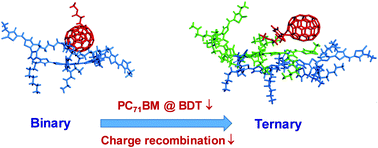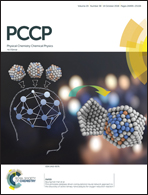Suppressing charge recombination in small-molecule ternary organic solar cells by modulating donor–acceptor interfacial arrangements†
Abstract
The ternary blending strategy has been a widely used method to achieve high performance in organic photovoltaics. However, the impact of the third component on the donor–acceptor interface geometries is still unclear, especially with regard to the microscopic structures in the mixed regions. In this study, we have investigated the donor–acceptor molecular packing structures in the mixed region as well as the exciton dissociation and charge recombination properties in all-small-molecule ternary solar cells based on the new DR3TBDTT:DR3TBDTT-E:PC71BM system by means of molecular dynamics simulations combined with electronic-structure calculations. The simulated results reveal that the incorporation of 10% DR3TBDTT-E in the ternary blend can lead to a decrease in the probability of finding PC71BM close to the central electron-donating benzodithiophene moiety, and thus this can reduce the binding energy of the lowest charge-transfer state and the electronic coupling of charge recombination. However, with a further increase of the doping ratio, PC71BM aggregation becomes weak, which is harmful to electron transport. Therefore, superior performance can be only obtained with a proper amount of the third component for ternary blend solar cells.

- This article is part of the themed collection: 2018 PCCP HOT Articles


 Please wait while we load your content...
Please wait while we load your content...